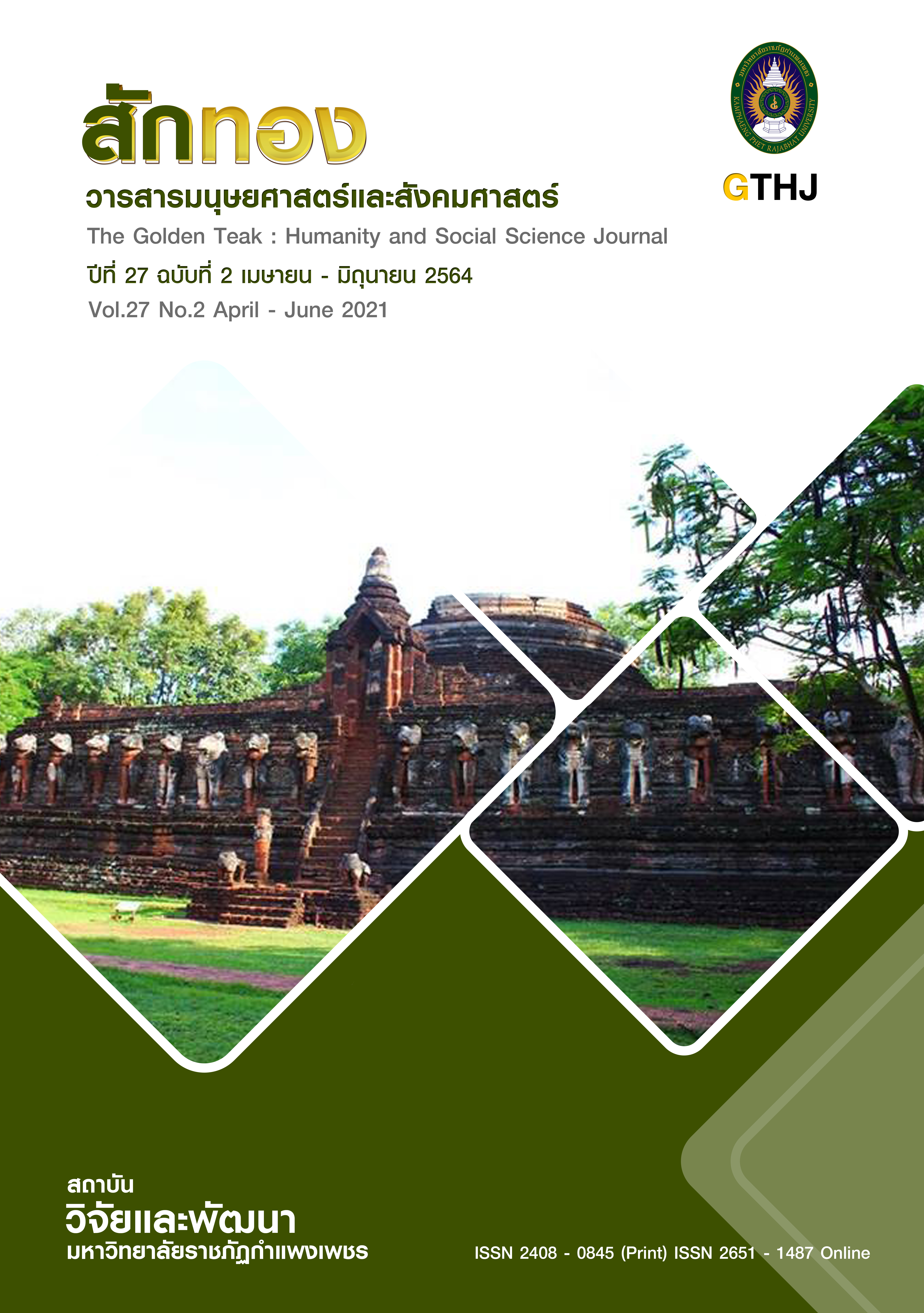The Effcts of Mathematics Learning Management Using Phases Methods Combinations Model With High-Order Questions on Mathematical Communication and Reasoning Abilities of Mathayomsuksa 2 Students
Main Article Content
Abstract
The purposes of this research were to compare the student’ s mathematical communication and reasoning abilities on “parallel lines” of mathayomsuksa 2 students after using phases method combinations model with high-order questions with 70 percent achievement criterion. The design of research was one-group posttest-only design. The subjects of this study were 32 Mathayomsuksa 2 students in the first semester of the 2018 academic year at Nonghuachangwittaya School. They were randomly selected by using cluster random sampling. The instruments used in the study were; 4 lesson plans, mathematical communication and reasoning abilities (with reliability of 0.89). The data were analyzed by mean, standard deviation, t-test for one sample and content analysis. The findings were as follows : 1. The mathematical communication and reasoning abilities on “parallel lines” of the sample group after obtaining instructional phases method combinations model together with high-order questions was statistically high than the 70 percent criterion at the .05 level of significance. 2. The mathematical reasoning abilities on “parallel lines” of the sample group after obtaining instructional phases method combinations model together with high-order questions was statistically high than the 70 percent criterion at the .05 level of significance.
Article Details
บทความที่ได้รับการตีพิมพ์เป็นลิขสิทธิ์ของวารสาร สักทอง : วารสารมนุษยศาสตร์และสังคมศาสตร์ สถาบันวิจัยและพัฒนา มหาวิทยาลับราชภัฏกำแพงเพชร
ข้อคิดเห็นใดๆ ที่ปรากฎในวารสารเป็นวรรณกรรมของผู้เขียนโดยเฉพาะ ซึ่งมหาวิทยาลัยราชภัฏกำแพงเพชรและบรรณาธิการไม่จำเป็นต้องเห็นด้วย
References
Angganapattarakajorn, V. (2011). Mathematical skills and processes. Chonburi : Department of learning management, Faculty of education, Burapha University.
_______. (2012). All about tips for teachers of mathematics : Curriculum, instruction and educational research. Bangkok : Charan Sanitwong printing.
Bureau of academic affairs and educationnal standards. (2008). Indicators and core content, Mathematics department, According to the core curriculum of basic education 2008. Bangkok : The agricultural co-operative federation of Thailand printing.,ltd.
Chaikarm, B. (2017, October 5). Teacher. Nonghuachangwittaya school, Buengkan province. Interview.
George, T. L. & Hans, O. A. (1970). Determining the level of inquiry in teacher’s questions. Dissertation abstracts international, 31(2), 395-400
Kennedy, Leonard M. & Tipps, Steve. (1994). Guiding children’s learning of mathematics.
(7 th ed.). California : Wadsworth.
Kullanatsiri, P. (2003). Questions that help develop mathematical process skills. Mathematical journal, 6, 4-8.
Malangtabtong, P. (2015). The effects of organizeing inductive and deductive learning on mathematical reasoning and written communication abilities in numbers theory of mathayomsuksa IV students. Master’s thesis, Mathematics teaching program, Faculty of education, Burapha University.
Markanong, A. (2010). Mathematical skills and processes : The development for evolution. (1 st ed.). Bangkok : Chulalongkorn University printing house.
Netnimit, D. (2015). Effects of instructional inquiry model (5Es) and high-order questions on mathematical reasoning ability and mathematical concepts of function of matthayomsuksa four students. Master’s thesis, Mathematics teaching program, Faculty of education, Burapha University.
Nikoloudakis, E. (2009). A proposed model to teach geometry to first-year senior high school students. helenic mathematics society international journal for mathematics in education, 2,(17-45).
Pasang, P. (2018, July 10). Teacher. Nonghuachangwittaya school, Buengkan province. Interview.
Pattanatrakunsook, K. (2003). Does the teaching of mathematics at Mathayomsuksa in Thailand really fail. Mathematical journal, 46(474-475), 54-58.
Pengsrikote, S. (2006). That question...how important. Withayajarn journal, Burapha University, 105(5), 58-61.
Pillawat, N. (2014). Teaching Children about Critical Thinking. [Online]. Available : http://taamkru.com/th/ถามอย่างไรให้ลูกคิดเป็น. [2017, September 18].
Santawee, B. (n.d.). Preparation for science teaching to ASEAN : case study of PISA and
O-NET scores. [Online]. Available : www.nstda.or.th/กรณีศึกษาคะแนน PISA 290313. [2017, September 28].
Tebneeramit, K. (2018, July 10). Teacher. Nonghuachangwittaya school, Buengkan province. Interview.
The institute for the promotion of teaching science and technology. (2012 A). Professional math teacher, The road to success. Bangkok : 3-Q media company limited.
_______. (2013). Assessment PISA 2102 mathematics, reading and science, summary for executive. Samut Prakan : Advanced printing service.
_______. (2017). Key points and educational implications from PISA 2015: summary for executive. [Online]. Available : https://drive.google.com/file/d/0BwqFSkq5b7zSR21DbUJlUENTeXc/view.
[2017, September 28].
The institute for the promotion of teaching science and technology (IPST), Ministry of education. (2012). Mathematical skills and processes. (3 rd ed.). Bangkok : 3-Q media company limited.
_______. (2012 A). Mathematics evaluation. Bangkok : S.P.N.
Toomtong, B. (2011). Learning mathematics research. Mahasarakham : Mahasarakham University.
Weerayatum K. (n.d.). Questioning techniques. [Online]. Available : http://www1.nsdv.go.th/ innovation/questioning.htm. [2017, October 5].
Yodfaiin, K. (2013). Effects of organizing mathematics learning activities using phases-methods combinations model and strategies for advancing mathematical thinking on mathematical reasoning and visualization abilities of ninth grade students. Master’s thesis, Mathematics education, Faculty of education, Chulalongkorn University.


